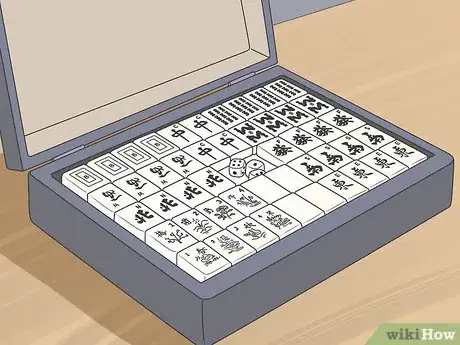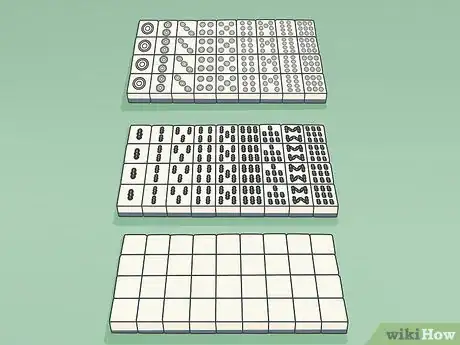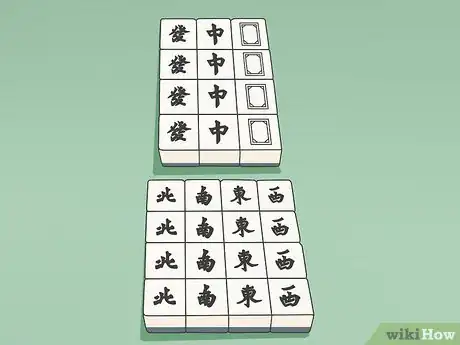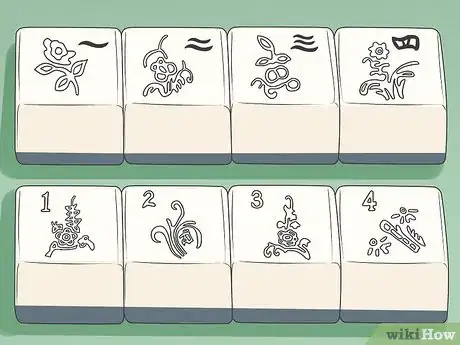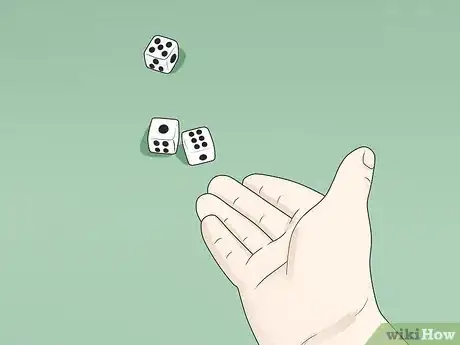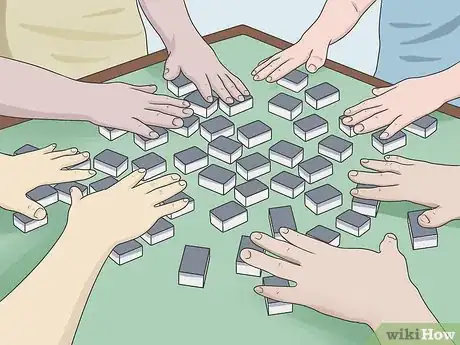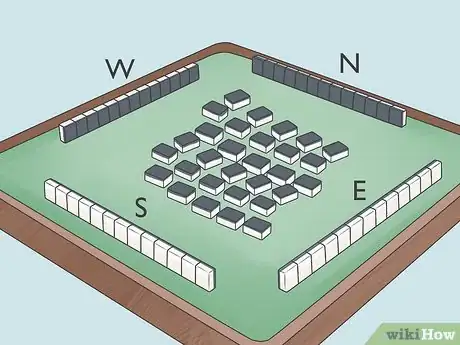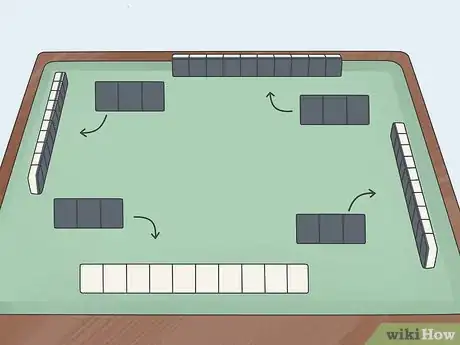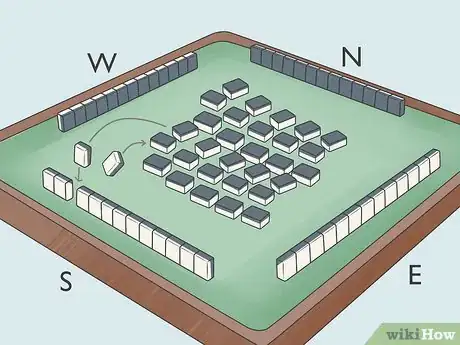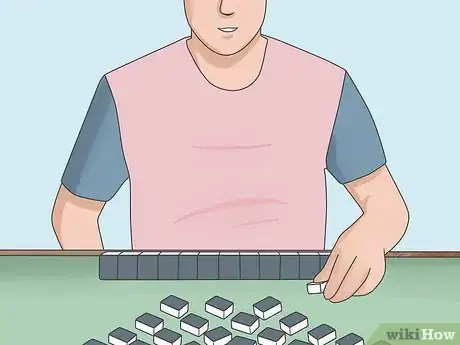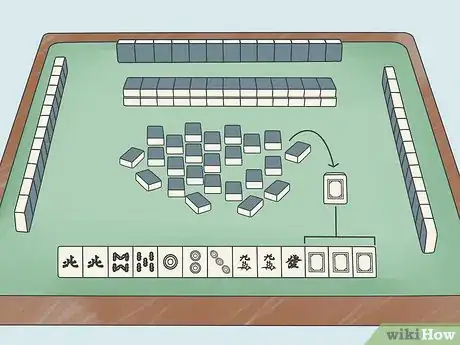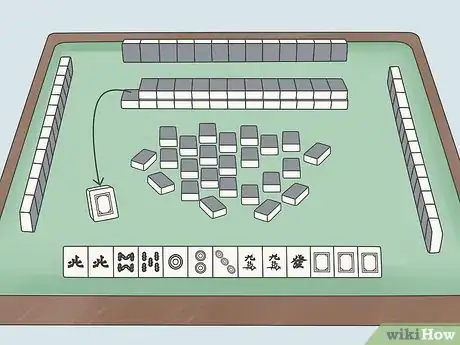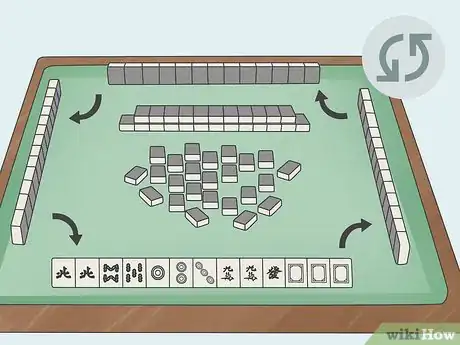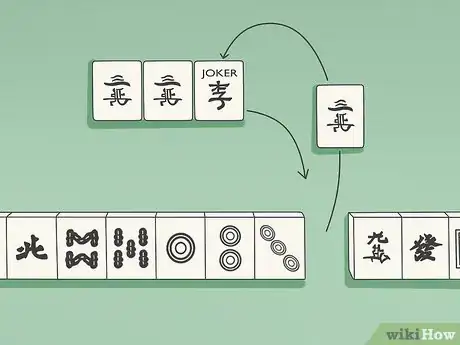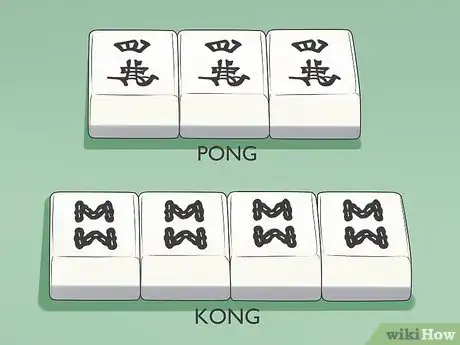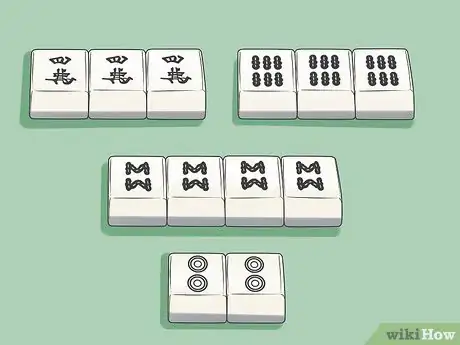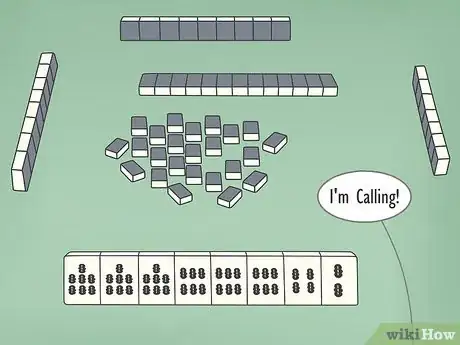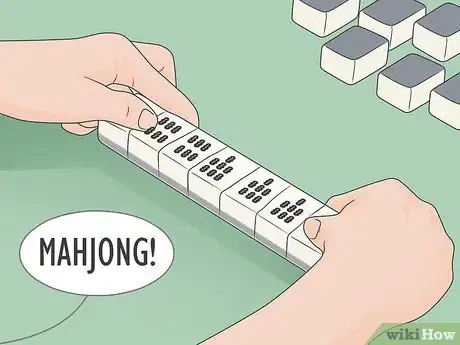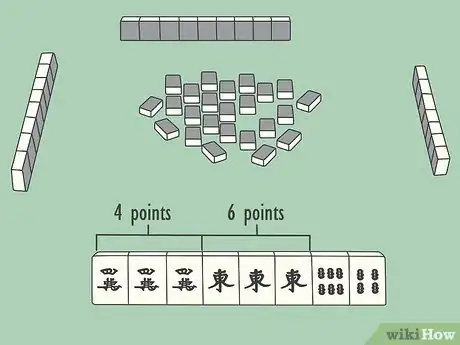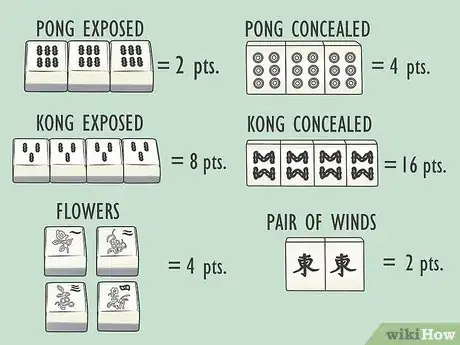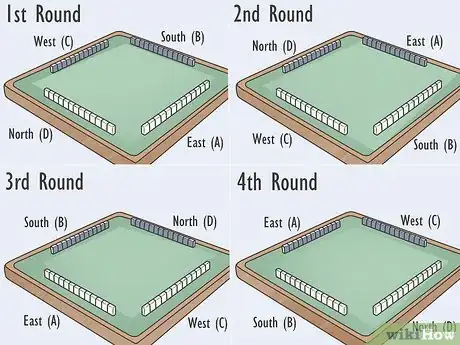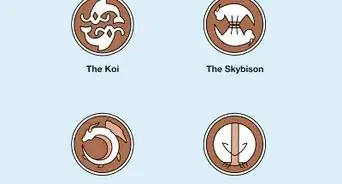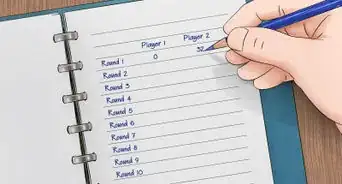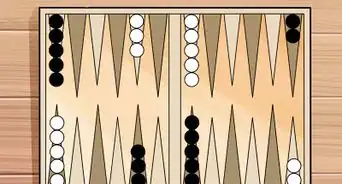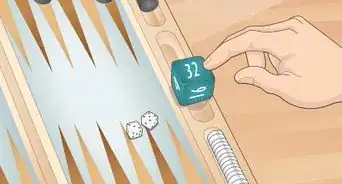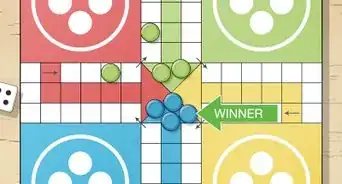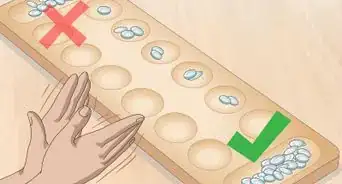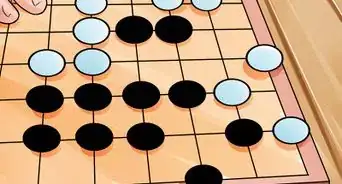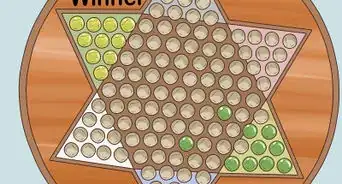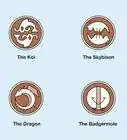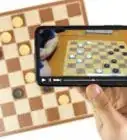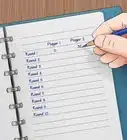This article was co-authored by wikiHow Staff. Our trained team of editors and researchers validate articles for accuracy and comprehensiveness. wikiHow's Content Management Team carefully monitors the work from our editorial staff to ensure that each article is backed by trusted research and meets our high quality standards.
There are 18 references cited in this article, which can be found at the bottom of the page.
wikiHow marks an article as reader-approved once it receives enough positive feedback. In this case, 84% of readers who voted found the article helpful, earning it our reader-approved status.
This article has been viewed 553,613 times.
Learn more...
Mahjong is a strategy game that originated in China. It's similar to rummy, but it's played with tiles instead of cards. Generally, you play with 4 people, though you can play with 3 as well. The goal is to form 4 melds and a pair, creating mahjong. You'll find there are many variations of mahjong, so these rules aren't definitive. You should always defer to the rules of the people you're playing with.
Steps
Learning the Tiles
-
1Find a set of mahjong tiles. A set consists of 144 tiles. You can find these sets online at a variety of price points, so don't worry, you won't need to shell out a lot of money if you don't want to! You should also be able to find them at gaming stores.[1]
- Keep in mind that different versions of the game have a different number of tiles. Some only have 136, for instance.
- Some sets are very expensive because they are hand carved!
-
2Learn the suit tiles first. The game uses 3 suits for the main part of gameplay, which are dot/circles, Chinese characters, and bamboo. These function much like suits in a deck of cards. Each suit has 4 identical sets of 9 tiles. There are 108 of these tiles in total.[2]
- The suits tiles will have numbers, 1-9, and like playing cards, each tile will have a corresponding amount of the respective symbol, except for the character suit, which has the Chinese character for the number. The number 1 tile for bamboo is a bird, typically an owl or a peacock.
Advertisement -
3Use honor tiles like suit tiles. Honor tiles are special tiles. Honor tiles show red and green dragons or the 4 winds. You can use these almost like suit tiles in that you can match them to make "melds," 3-of-a-kind or 4-of-a-kind.[3]
- You'll have 16 wind tiles, 4 each of east, south, west, and north, which you play in that order: remember "eat soy with noodles." They typically have the first letter of the word in the upper left-hand corner.
- The dragons are usually represented by Chinese characters, but they'll also have a "C," "F," or "P/B" on them instead of the numbers 1-9 like the suit tiles. You get 4 sets of the same 3 tiles.[4]
-
4Decide whether you will use the bonus tiles. Bonus tiles show seasons and flowers. Typically, you include these tiles in Chinese and Korean versions of Mahjong, but not always in American or Japanese versions. You can't use these to make melds, but they can give you extra points in your hand at the end.[5]
- The pictures on these tiles vary by set. A set might have plum, orchid, chrysanthemum, and bamboo flowers, 1 of each. Then, it will have 1 tile for each season. You might also have 4 blank tiles, which can be used as jokers.
Starting a Round
-
1Roll a set of dice to see who will be the East Wind. The East Wind is the dealer for that game. Whoever rolls the highest on 2 dice is designated as the East Wind. The West Wind is across from the East Wind, while the North Wind is to the East's left and the South is to the East's Right.
- The person to the right of the East Wind, the South Wind, goes first.[6]
-
2Place the tiles face-down to shuffle them and deal. Set all the tiles in the middle of the table and turn them upside-down. Mix them around with your hands to shuffle the tiles. The East Wind can decide when the tiles are shuffled enough.[7]
-
3Have the East Wind deal 13 tiles to each person. The East Wind deals 1 tile to each player at a time. When each player has 13, stop dealing. You'll have tiles leftover. Just leave them in the middle in a group, as you'll draw from them throughout the game. Line up the tiles facing you to form your hand.[8]
- In traditional mahjong, you make a wall of tiles in front of each player before dealing, 36 tiles each in stacks of 2. Then you push all the walls together to form a square. The East Wind throws 2 dice, then counts from the right to that point in the wall and pushes 2 stacks of tiles forward to put in their hand. Players take turns pulling out stacks, 2 stacks at a time until they reach 12 each. Then, the East takes 2 tiles and the other 3 players take a single tile.
-
4Pass tiles using the "Charleston" rule in American mahjong. This rule is a variant, and it's typically only used in the American version. It's divided into 3 parts. You must do the Charleston the first time. All you do is take 3 tiles from your hand that you want to discard and pass them to the right, called the first pass. Then you do the same with the person across from you (second pass) and then for the person to your left (third pass). If everyone agrees, you can do the whole process a second time, but if 1 person says "no," you don't.[9]
- On the third pass, you can use a "blind" pass, meaning you can move 1-3 tiles that are passed to you on to the next person without looking at them. Make sure you still pass 3, making up the extra from your hand.
- You can also do a courtesy pass at the end, where the players across from each agree to exchange 1-3 tiles. This is optional, and both players must agree on the pass, stating how many tiles they want to exchange. Whichever number is lower is the one used.
Playing a Round
-
1Let the South Wind draw and discard a tile to start the round. The South Wind can pick up a tile and look it. If they want to keep it, they must discard a tile from their hand. Otherwise, they can discard the one they picked up. When picking up a tile from the wall, you continue from the point where you stopped when the tiles were dealt and keep moving in the same direction; if you have a pile, just take any tile from the pile.[10]
- To decide whether to keep a tile, check to see if it matches any tiles in your hand. You're trying to form melds, which includes 3-of-a-kind, 4-of-a-kind, and straights.
- If you used the wall method of dealing tiles, then the East has 14 tiles. In that case, the East Wind can discard a tile to start the game, which anyone can claim. [11]
-
2Allow the South Wind to discard the tile and say the name. Every time you pick up a tile, either one a person has discarded or one from the draw pile, you must discard a tile from your hand. Place the tile on the table, and then say the name of the tile so that others can claim it.[12]
- Discarded tiles just go into the middle of the table. You can line them up if you wish.
-
3Claim a tile as it's discarded if it fits one of your melds. If the tile completes a pong, meaning you already have the other 2 tiles in your hand, you can say "pong" and claim the discarded tile. Similarly, you can claim the tile if it completes a kong or chow in your hand, and you say it aloud when you claim it. Then, you must show the meld and put it on the table to prove it. This type of claiming goes in the order of players with one exception: if the tile would allow a player to win mahjong, they get the tile.[13]
- Some variations only allow you to claim the third tile of a chow from the person directly before you.
- If you've played a 3-tile pong on the table, you can't claim the fourth tile, though you can play it if you draw it from the wall/draw pile.
- You can play a whole game without showing any melds from your hand, which is called "concealed melds," but you can't claim any discarded tiles. Not showing melds gives you extra points. Melds laid on the table are called "exposed melds."
-
4Pick up a tile from the draw pile to play if you don't want a discarded tile. If no one claims the discarded tile, then the next player to the right of the person discarding picks up a tile from the draw pile/wall. Once you rack a tile, no one can claim the previously discarded tile.[14]
- If you've picked up a tile and looked at but haven't racked it yet, someone can still claim the discarded tile. In that case, you need to put the tile you picked up back where it came from.
-
5Continue in the order of players to the right. Once someone claims a discarded tile, play goes to the right of that player, even if they weren't the next player in line to go. Whenever a discarded tile is claimed, the turn skips to that person, and then play continues from them.[15]
- If you are mainly drawing tiles, then play just goes from person to person.
-
6Replace a joker with a tile from your hand on your turn. If someone lays down a meld with a joker and you have the tile that replaces the joker, you can put down the tile. Then, you can claim the joker to use in your hand.[16]
- You do this on your turn after you've picked up and racked a tile.
-
7Work on forming melds. Melds are sets of tiles you play together. You can play 3 of the same tile ("pongs") or 4 of the same tile ("kongs"). These tiles can be suits, honor tiles, or bonus tiles. You can also play 3 numbers in a row, called a chow.[17]
- These are similar to 3-of-a-kind, 4-of-a-kind, and a run or a straight in rummy.
- In some versions, you can only have 1 chow in your hand. Chows do not give you points at the end, but they contribute to forming mahjong.
- When you lay out melds, place the long ends next to each other and group them in front of you.
- The only time you "play" a meld is when you claim a discarded tile, as you have to show your meld then. Otherwise, you wait until you call mahjong to reveal your melds, much like gin rummy.
-
8Make a mahjong with 4 melds and a pair. The mahjong hand uses all the tiles in your hand, which is 13, plus 1 you won't discard. You'll need 4 melds, which can be a combination of pongs, kongs, and chows, plus 1 pair. Any bonus tiles will also give you points.[18]
- For instance, you might have 2 melds that are 3-of-a-kind and 1 that's a run of 3, plus a pair.
Winning and Scoring
-
1Say "I'm calling" when you're 1 tile away from mahjong. That lets the other players know they only have a limited time to beat you. Other players can call on their turn, too, after you've made the call.
-
2Show your hand and say "mahjong" when you complete the set. You need to have all of your melds and your pair in place before you say mahjong. If you don't actually have mahjong, then you are disqualified for the rest of the game.[19]
- Play continues without that player if the hand is disqualified.
-
3Score just the winning hand. While there are many variations for how you can calculate scores, the easiest way is to just count the winning hand. Mahjong is played over many rounds, so points will add up over those rounds.[20]
- If you don't want to score only the winning hand, then you score each person's hand essentially the same, but the mahjong hand gets an extra 20 points.
-
4Apply points based on the tiles in the winning hand. Chows don't score any points. A pong gets 2 points if it's exposed or 4 if it's concealed, while a pong of 1s and 9s, dragons, or winds is worth 4 if exposed and 8 if concealed. Kongs are worth 8 (exposed) and 16 (concealed) or 16 and 32 if they use 1s and 9s, dragons, or winds.
- Each flower or season gets 4 points, while a pair dragons or your own wind gets 2 points.
-
5Play 4 rounds of 4 hands each. Typically, a game of mahjong consists of 4 rounds. Within each round, you play 4 "hands." With each hand, you play until someone gets mahjong. During this time, you rotate who deals and even the seating positions.[21]
Community Q&A
-
QuestionCan I pick a discarded tile for mahjong?
 Community AnswerIn Japanese or Chinese mahjong, yes, you may pick a tile any opponent discarded. If several people call the tile, mahjong takes priority over kan, pong or chi, and the player to the left of the discardee takes priority when more than one player calls mahjong (or ron in Japanese mahjong).
Community AnswerIn Japanese or Chinese mahjong, yes, you may pick a tile any opponent discarded. If several people call the tile, mahjong takes priority over kan, pong or chi, and the player to the left of the discardee takes priority when more than one player calls mahjong (or ron in Japanese mahjong). -
QuestionDo I also need cards to play this?
 Community AnswerNo, you do not.
Community AnswerNo, you do not. -
QuestionCan two people play Mahjong?
 Community AnswerIt is not possible for two players to play Mahjong by the standard rules. It requires four players.
Community AnswerIt is not possible for two players to play Mahjong by the standard rules. It requires four players.
References
- ↑ https://www.cbc.ca/life/culture/the-beginner-s-guide-to-the-greatest-pastimes-mahjong-1.4739808
- ↑ https://www.youtube.com/watch?v=485HdYb1r8M&feature=youtu.be&t=34
- ↑ https://www.cbc.ca/life/culture/the-beginner-s-guide-to-the-greatest-pastimes-mahjong-1.4739808
- ↑ https://www.youtube.com/watch?v=485HdYb1r8M&feature=youtu.be&t=55
- ↑ https://www.cbc.ca/life/culture/the-beginner-s-guide-to-the-greatest-pastimes-mahjong-1.4739808
- ↑ https://www.youtube.com/watch?v=485HdYb1r8M&feature=youtu.be&t=89
- ↑ https://www.youtube.com/watch?v=tRCb_LOkEmQ&feature=youtu.be&t=147
- ↑ https://www.youtube.com/watch?v=485HdYb1r8M&feature=youtu.be&t=98
- ↑ http://aimj.altervista.org/extraregolamenti/american-mahjong-rules.pdf
- ↑ https://www.youtube.com/watch?v=485HdYb1r8M&feature=youtu.be&t=117
- ↑ http://www.ateacherfirst.com/wp-content/uploads/2010/01/Mahjong-2016-Instructions-1.pdf
- ↑ aimj.altervista.org/extraregolamenti/american-mahjong-rules.pdf
- ↑ aimj.altervista.org/extraregolamenti/american-mahjong-rules.pdf
- ↑ http://www.ateacherfirst.com/wp-content/uploads/2010/01/Mahjong-2016-Instructions-1.pdf
- ↑ http://www.ateacherfirst.com/wp-content/uploads/2010/01/Mahjong-2016-Instructions-1.pdf
- ↑ http://www.ateacherfirst.com/wp-content/uploads/2010/01/Mahjong-2016-Instructions-1.pdf
- ↑ https://www.youtube.com/watch?v=tRCb_LOkEmQ&feature=youtu.be&t=172
- ↑ https://www.youtube.com/watch?v=tRCb_LOkEmQ&feature=youtu.be&t=205
- ↑ http://www.ateacherfirst.com/wp-content/uploads/2010/01/Mahjong-2016-Instructions-1.pdf
- ↑ https://www.youtube.com/watch?v=tRCb_LOkEmQ&feature=youtu.be&t=273
- ↑ https://www.mahjongtime.com/chinese-official-mahjong-rules-4.html
- ↑ https://www.cbc.ca/life/culture/the-beginner-s-guide-to-the-greatest-pastimes-mahjong-1.4739808
About This Article
Mahjong is a fun 4-player game where players try to form melds with tiles to score points. The goal of the game is to get the highest score by creating a mahjong, which is 4 melds and a pair. A meld is a set of 3 matching tiles (pong meld), 4 matching tiles (kong meld), or 3 consecutive numbers in the same suit (chow meld). There are 3 suits: bamboos (or sticks), characters, and dots. The tiles within the suits are numbered 1 through 9. There are also 4 wind tiles, 3 dragon tiles, 4 flower tiles, and 4 season tiles. To start the game, mix all 144 tiles together face-down, then divide them evenly among the players. Each player makes a wall in front of them with their 36 tiles by stacking 1 row of 18 tiles on another row of 18 tiles. Then, everyone pushes their rows together to form a square. Each player picks up 13 tiles from the row on their side. Next, each player rolls 2 dice and the highest number goes first. On a player's turn, they start by drawing a new tile from their row. If they draw a tile that makes a meld with the other tiles in their hand, they can call it out and lay the tiles in the meld face-down in front of them. After a player draws a tile and plays any melds they have, they discard a tile from their hand by placing it face-up in the middle of the square. Finally, they draw a new tile from their row to end their turn, and the player to their left goes next. At any point in the game, any player can pick up a tile from the middle of the square to make a meld, whether it's their turn or not. Players can also pick up a pair with the wind, dragon, flower, or season tiles. Each time a player claims a tile to make a meld or pair, they must announce it out loud before picking up the tile and setting it face-up in front them. The game is over when one player has created a mahjong, or 4 melds and a pair of matching tiles. When a player scores a mahjong, they reveal their 4 melds and the pair. Only the winning mahjong is scored. When scoring a winning mahjong, any melds made with tiles from the center of the square are considered “exposed,” and any melds made using just the tiles in the player's hand are considered “concealed." Concealed melds are worth more points. An exposed pong is worth 2 points, an exposed kong is worth 8 points, and an exposed chow is worth 0 points. A concealed pong is worth 4 points, a concealed kong is worth 16 points, and a concealed chow is worth 0 points. A pair of winds or dragons is worth 2 points, and 4 flowers are worth 4 points. Any other pairs are worth 0 points. After you score the winning Mahjong, shuffle the winning tiles and play another round. Play 4 rounds in total. The player with the highest score after 4 rounds wins the game! To learn more about creating melds, read on!
